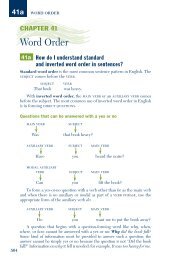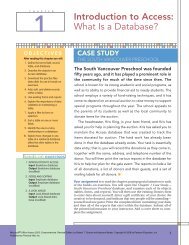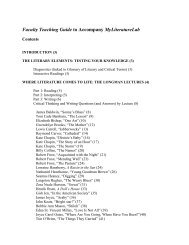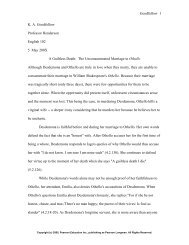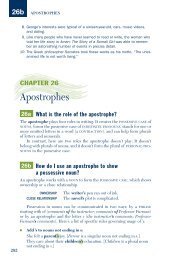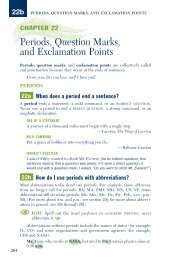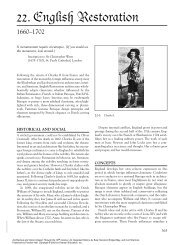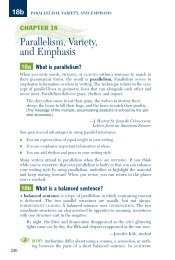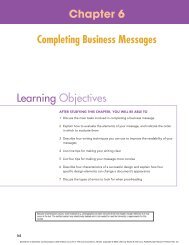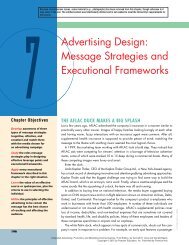chapter 3 - Pearson Learning Solutions
chapter 3 - Pearson Learning Solutions
chapter 3 - Pearson Learning Solutions
Create successful ePaper yourself
Turn your PDF publications into a flip-book with our unique Google optimized e-Paper software.
2009934667<br />
Chapter 3 Nonverbal Communication 67<br />
without our even knowing it. For example, when the pupils of our eyes are dilated,<br />
we may appear friendlier, warmer, and more attractive.<br />
A person’s eye blinks have an effect on how he or she is perceived by others.<br />
For example, the slowness or rapidity of eye blinks can indicate nervousness. The<br />
normal blink rate for someone speaking is 31 to 50 blinks per minute. During the<br />
first presidential debate in 1996 between President Clinton and his Republican<br />
opponent, Bob Dole, polls indicated that Mr. Dole was considered to be very nervous.<br />
A review of the videotapes of the debate revealed that he had averaged 147<br />
eye blinks per minute, almost three times the normal rate. 37<br />
A theory known as pupilometrics indicates that pupils dilate when the eyes<br />
are focused on a pleasurable object and contract when focused on an unpleasurable<br />
one. 38 Enlarged pupils signify interest, and contracted pupils reflect boredom.<br />
Thus, knowledgeable teachers often watch the pupils of their students’ eyes to<br />
ascertain their interest in a particular lesson. The idea of wide-eyed wonder and<br />
interest is not new. In the late eighteenth century, European women placed a drug<br />
called belladonna in their eyes to keep their pupils large in order to make them<br />
look both interested and interesting.<br />
Members of different social classes, generations, ethnic groups, and cultures<br />
use their eyes differently to express messages. European Americans often complain<br />
that they feel some foreigners stare at them too intensely or hold a glance too long.<br />
This is because a gaze of longer than ten seconds is likely to induce discomfort in<br />
a European American. But lengthy eye contact may be comfortable as long as the<br />
communicating people have sufficient distance between them. As you walk down<br />
a corridor, notice that you can look at someone for a long period of time until<br />
you suddenly feel uncomfortable and glance away. This usually happens at a<br />
distance of about ten feet.<br />
When individuals in the European American culture are intent on hiding an<br />
inner feeling, they may try to avoid eye contact. Thus, the child who has eaten<br />
forbidden candy will not look at a questioning parent during the interrogation.<br />
(European American children are often told, “Look me in the eye and say that.”)<br />
People in many cultures are very aware of the part played by eyes in communicating.<br />
This awareness has led some to try to mask their eyes. “Since people<br />
can’t control the responses of their eyes,” reported one source, “many Arabs wear<br />
dark glasses, even indoors.” 39 This is especially true if they are negotiating.<br />
Thus, in addition to watching a person’s actions, an astute observer may ascertain<br />
what that person is doing by watching his eyes. For example, when 90 percent<br />
of people look up and to the left, they are recalling a visual memory they<br />
have experienced. Eyes up and to the right picture a future thought. 40<br />
Gestics Gestics is the study of the movements of the body, such as gestures,<br />
which can give clues about a person’s status, mood, cultural affiliations, and selfperception.<br />
Why do people gesture when they talk? A study indicates that speech<br />
and gesturing function together and may help us think and form words. 41 In addition,<br />
gesturing helps people retrieve words from memory. “When asked to keep<br />
their hands still by holding onto a bar, people had a more difficult time recalling<br />
words than those whose hands were free.” 42 Nods of the head and body shifts can<br />
encourage or discourage conversation. Other movements may show internal feelings.<br />
For example, those who are bored may tap their fingers on a table or bounce<br />
a crossed leg.<br />
As people attempt to communicate, they use gestures. These gestures may be<br />
classified as speech independent or speech related. Speech-independent gestures<br />
are not tied to speech. These gestures are referred to as emblems. 43 Speech-related<br />
Communicating: A Social and Career Focus, Tenth Edition, by Roy M. Berko, Andrew D. Wolvin, and Darlyn R. Wolvin. Published by Allyn & Bacon.<br />
Copyright © 2007 by <strong>Pearson</strong> Education, Inc.




